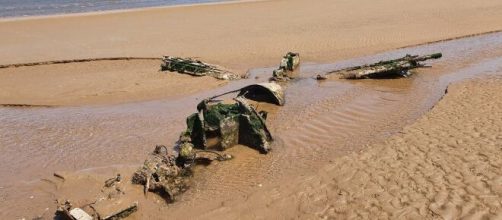Cleethorpes is located on the eastern coast of England. It's a seaside resort with a rich history that also happens to be the location of a famous UFO sighting. As you might imagine, it's a fairly popular spot with tourists—even some very unexpected ones.
It also happens to be just a few miles away from what was once a Royal Air Force base. RAF North Coates was in service for about 75 years before becoming a private airfield. But reminders of the area's RAF history can still be found.
Missing World War II plane found on a beach
Debi Hartley and Graham Holden were walking on a beach of May 25.
They were with their dogs, Bonnie. Apparently, they had walked along the same route many times in the past. But this time they found something new.
It would turn out to be the remains of a fighter plane from the Second World War. According to MSN, it's believed to be a Bristol Beaufighter. The Beaufighter was produced during the late 1930s and the 1940s. It was primarily flown by the United Kingdom's Royal Air Force and Royal Navy, although it was also used by the United States, Canada, Australia, New Zealand, South Africa, and Poland.
It was a so-called heavy fighter, designed to carry heavy weapons and operate at long ranges. The Beaufighter would emerge as a preeminent fighter for night missions, maritime strikes, and ground attacks.
It played a prominent role in engagements, including the Battle of Britain and the Battle of the Bismarck Sea.
Finding a missing example of such a historical artifact has likely thrilled many. But the BBC indicates that any hopes of salvaging it would probably have to wait. Fast-moving tides have made the area a dangerous place to be.
Her Majesty's Coastguard has tried to dissuade curious people from searching out the wreckage themselves out of safety concerns. By the time conditions settle down, the wreckage could well be buried under heavy sand once again.
Most likely a plane lost in a training crash
After the discovery, the airplane was made, work quickly began to try to identify how it got there.
And researchers may have come up with an answer. Not surprisingly, it seems to involve RAF North Coates.
The apparent Bristol Beaufighter is thought to have had the serial number JM333. It was part of No. 254 Squadron RAF. On April 21, 1944, the plane took off on a training run from RAF North Coates. Quickly into the flight, a double-engine failure occurred, ultimately leading to a crash. Evidently, the wreckage was never recovered, and over time it was covered by sand and waves.
There were two members aboard the plane when the engines failed. Both would survive the ensuing wreck, apparently without being seriously injured.


